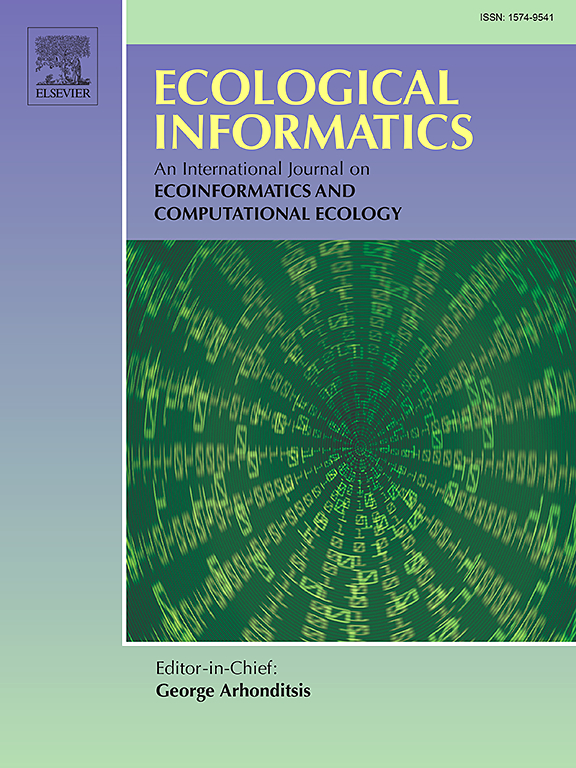Coral reef detection using ICESat-2 and machine learning
IF 5.8
2区 环境科学与生态学
Q1 ECOLOGY
引用次数: 0
Abstract
As anthropogenic impacts threaten natural habitats, effective monitoring strategies are crucial. Coral reefs, among the most vulnerable ecosystems, traditionally employ monitoring techniques that are labor-intensive and costly, prompting the exploration of remote sensing as a cost-effective alternative. Launched in October 2018, the Ice, Cloud, and land Elevation Satellite-2 (ICESat-2) provides high-resolution, high-frequency data, with its green laser offering unprecedented opportunities for bathymetric and coral reef applications. This study investigates the use of ICESat-2 data for atoll coral reef detection, utilizing Heron Island in the Great Barrier Reef, AU, and employing machine learning models. A binary logistic regression (BLR) model and convolutional neural network (CNN) were tested for determining coral reef presence, with the CNN outperforming the BLR in accuracy (85.4%), F1 score (43%), and false positive rate (13.1%). A challenge of the study included the difficulty of balancing false positive rates in predictive models to avoid over- or underestimations of reef extent. These obstacles were mitigated through the integration of algorithmically derived pseudo-rugosity and slope metrics as innovative proxies for seafloor complexity, significantly improving predictive performance. Feature importance analysis identified satellite-derived bathymetry (SDB) depth as the most critical predictor of coral presence, followed by pseudo-rugosity, slope, and various other depth measurements. This research establishes a new application of ICESat-2 data combined with advanced machine learning techniques as a promising method for efficient and cost-effective coral reef monitoring. Future work should refine algorithms and incorporate additional environmental variables to improve model performance across various reef types.
利用ICESat-2和机器学习进行珊瑚礁探测
由于人为影响威胁到自然栖息地,有效的监测策略至关重要。珊瑚礁是最脆弱的生态系统之一,传统上采用的监测技术劳力密集,费用昂贵,促使人们探索将遥感作为一种具有成本效益的替代办法。2018年10月发射的冰、云和陆地高程卫星2号(ICESat-2)提供高分辨率、高频数据,其绿色激光为测深和珊瑚礁应用提供了前所未有的机会。本研究调查了ICESat-2数据在环礁珊瑚礁探测中的使用,利用了澳大利亚大堡礁的Heron岛,并采用了机器学习模型。采用二元逻辑回归(BLR)模型和卷积神经网络(CNN)模型对珊瑚礁的存在进行了测试,CNN在准确率(85.4%)、F1得分(43%)和假阳性率(13.1%)方面优于BLR。这项研究的一个挑战包括难以平衡预测模型中的假阳性率,以避免对珊瑚礁范围的高估或低估。通过整合算法衍生的伪鲁度和斜率指标作为海底复杂性的创新代理,这些障碍得到了缓解,显著提高了预测性能。特征重要性分析发现,卫星水深测量(SDB)深度是珊瑚存在的最关键预测指标,其次是伪粗糙度、坡度和各种其他深度测量。本研究建立了ICESat-2数据与先进机器学习技术相结合的新应用,作为一种有效且具有成本效益的珊瑚礁监测方法。未来的工作应该改进算法,并纳入额外的环境变量,以提高模型在各种珊瑚礁类型中的性能。
本文章由计算机程序翻译,如有差异,请以英文原文为准。
求助全文
约1分钟内获得全文
求助全文
来源期刊

Ecological Informatics
环境科学-生态学
CiteScore
8.30
自引率
11.80%
发文量
346
审稿时长
46 days
期刊介绍:
The journal Ecological Informatics is devoted to the publication of high quality, peer-reviewed articles on all aspects of computational ecology, data science and biogeography. The scope of the journal takes into account the data-intensive nature of ecology, the growing capacity of information technology to access, harness and leverage complex data as well as the critical need for informing sustainable management in view of global environmental and climate change.
The nature of the journal is interdisciplinary at the crossover between ecology and informatics. It focuses on novel concepts and techniques for image- and genome-based monitoring and interpretation, sensor- and multimedia-based data acquisition, internet-based data archiving and sharing, data assimilation, modelling and prediction of ecological data.
 求助内容:
求助内容: 应助结果提醒方式:
应助结果提醒方式:


